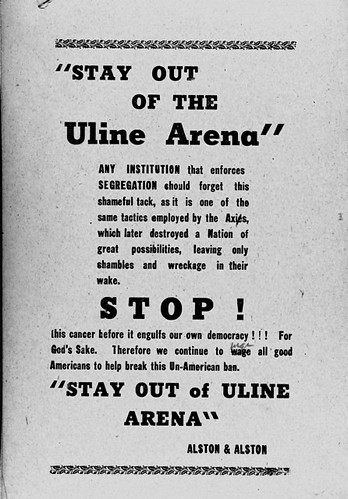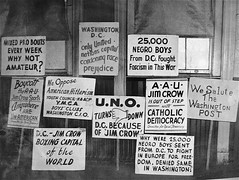Images from the Uline Arena Integration Campaign (1942?)
Digging back through history is always difficult, because even if you "read" everything, you may never really get the full story. I haven't delved into the papers of E.B. Henderson, which are at the Moorland-Spingarn Collection at Howard University. Dr. Henderson was a seminal figure in DC athletics, in the Public Schools and beyond. He also was an important civil rights activist particularly active in NAACP efforts in the greater Washington region.
When we wrote the landmark nomination for the building, we were aware of the importance this site played in Civil Rights issues. For example, Paul Robeson had a concert at the Uline because he was barred from performing in Constitution Hall. It's arguable, but it appears as if the first African-American to step on the court in what is now the NBA, Earl Lloyd, played for the Washington Capitols at Uline Arena (although his first game was an away game at Syracuse). Later, both Elijah Muhammad and Malcolm X appeared at Nation of Islam events held in Uline Arena.
And, in the files at the Washingtoniana Collection, there are copies of articles about protests around segregated policies at the Uline Arena. Originally, boxing matches were integrated (probably because of competition with "Turner Arena" in the U Street area), but the policy for other events were, according to Mr. Uline, up to the discretion of the promoter of the particular event. Later articles discuss that the Arena became integrated, but according to the owner Mr. Uline, not because of the protests.
What we didn't know, and learned at a presentation at the City Museum in March 2004, was that Dr. Henderson and others led a protest campaign to integrate Uline Arena, and that as part of the campaign, they protested outside of every event held at the Arena for an entire year.
That demonstrates incredible commitment and perserverance.
Yesterday, I was finally able to get copies of the two images that remain from this campaign, which are depicted below. Also, for information on the proposal to redevelop the Uline Arena site, click here.
 Images from the Collection of E.B. Henderson II (Dr. Henderson's grandson).
Images from the Collection of E.B. Henderson II (Dr. Henderson's grandson).
 Protest Signs, Campaign to integrate Uline Arena, (1942?).
Protest Signs, Campaign to integrate Uline Arena, (1942?).



0 Comments:
Post a Comment
<< Home